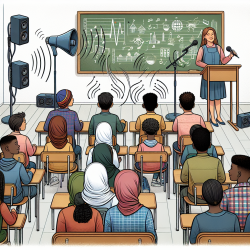In the dynamic landscape of educational audiology, the integration of sound-field FM amplification systems in classrooms represents a significant advancement in supporting diverse learning needs. Drawing insights from "Sound-Field FM Amplification: Theory and Practical Applications (1995)" by Carl C. Crandell, Joseph J. Smaldino, and Carol Flexer, this comprehensive guide explores the theoretical underpinnings and practical applications of these systems to enhance classroom learning environments.
Understanding the Basics of Sound-Field FM Amplification
At its core, sound-field FM amplification is a technology designed to improve the acoustic environment of classrooms. By amplifying the teacher's voice and distributing it evenly throughout the classroom, all students, regardless of their seating position, receive clear and intelligible speech. This technology not only benefits students with hearing impairments but also aids those with attention deficits, language processing disorders, and typical hearing abilities in noisy classrooms.
Theoretical Foundations
The first section of the book delves into the theoretical aspects of speech perception and classroom acoustics. It highlights how various factors, including teacher voice characteristics, distance, noise, and reverberation, can significantly impact a student's ability to listen, understand, and learn. Moreover, it sheds light on why certain populations, such as English as a Second Language (ESL) learners or children with minimal hearing loss, are more at risk in traditional classroom settings.
Practical Applications and Classroom Management
Moving beyond theory, the book offers a wealth of practical advice on evaluating classroom acoustics, selecting and installing sound-field systems, and integrating these technologies into daily teaching practices. It emphasizes the importance of a holistic approach, considering not just the technological aspects but also the pedagogical and environmental factors that contribute to an effective learning space.
Key highlights include:
- Detailed guidelines for assessing classroom acoustics, including measuring voice levels, noise, and reverberation times.
- Strategies for selecting the appropriate sound-field system, taking into account factors such as speaker placement, microphone types, and system troubleshooting.
- Insights into the role of teachers and students in maximizing the benefits of sound-field amplification, including awareness of sound, understanding the impact of acoustics, and developing effective listening and communication skills.
Research Evidence and Benefits
An extensive review of literature within the book provides compelling evidence of the benefits of sound-field FM amplification. Studies cited demonstrate improvements in speech recognition, academic achievement, attention, and overall learning outcomes. Furthermore, the positive feedback from teachers who have embraced this technology underscores its potential to transform classroom dynamics and student engagement.
Challenges and Considerations
Despite the proven advantages, the implementation of sound-field FM amplification systems is not without challenges. The book candidly addresses potential obstacles, such as funding issues, resistance from school administrators, and the need for ongoing teacher training and support. It also offers practical solutions and strategies for advocacy, emphasizing the importance of demonstrating the system's value in enhancing educational outcomes.
Conclusion and Further Reading
"Sound-Field FM Amplification: Theory and Practical Applications (1995)" serves as an invaluable resource for audiologists, speech-language pathologists, educators, and school administrators seeking to create more inclusive and effective learning environments. By combining theoretical insights with practical guidelines, it lays the groundwork for the widespread adoption and successful integration of sound-field FM amplification systems in classrooms.
For those interested in exploring this topic further and accessing the original research and discussions presented, Sound-Field FM Amplification: Theory and Practical Applications (1995) offers a comprehensive overview and practical insights into enhancing classroom learning through audiological technology.










